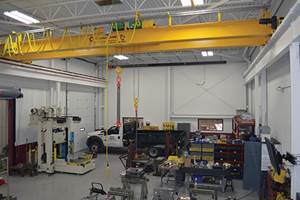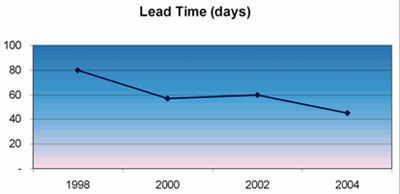Top Industry Trends & Developments
An overview of moldmaking-related trends and technologies to watch for in 2006.
Industry trends support being more competitive: being able to trim production time, increase quality and do so at lower cost. An overriding trend is the movement to near net shape—improvements in technology, machine accuracy, control technology, modeling software—that let the mold and toolmaker drop a piece that is very close to or exactly what the customer wants. No room is left for error: pieces are not finished by hand, with grinding or other methods.
What is assumed, of course, is the human factor: designers, programmers, machinists and other skilled employees who contribute to the company’s competitive edge. Talented, innovate and well-trained, these employees can collaborate with customers on designs that contain production costs while streamlining production.
Specific trends and technologies might include:
- 3-D printing (3DP). 3DP allows proto-types to be rendered quickly from CAD drawings. Thousands of thin layers of powder are used to create a 3-D model. Because the process bypasses patternmaking, it can hurry moldmaking straight to prototyping and casting. Reports have been heard of foundries reducing casting time from 17 to three days.
- Increased use of high-speed machining to reduce hand finishing of molds. Machining centers with light, fast, accurate milling passes now can machine a surface to its intended finish and dimensions and, by doing so, eliminate the need for hand finishing.
- Side-by-side machining. The number of setups and operations are reduced with side-by-side machining as compared to the use of conventional machining. The core and cavity of a mold are machined side-by-side—as left- and right-hand faces—from a single workpiece on a multitasking machine. Accuracy is enhanced as both mold halves retain perfect orientation to each other until separation.
- Parallel machining. Large mold components are machined in segments on smaller machining centers with high volumetric accuracy for significant savings in equipment and time. The finished segments are assembled into a complete core or cavity. In some cases, the segments can be designed to fit, as inserts, into packets in the mold base.
- Five-axis gundrilling. The number of setups required to complete a mold by drilling deep holes at angles that are not parallel to the machine’s axis are significantly reduced. The gundrilling is done without special fixtures.
- Zero/negative stock machining. The cost and time of mold building is reduced as the extra stock on the cores and cavities of molds is eliminated. The piece goes from milling machine to mold press to perfect molded part in one shot. The need for benching also may be practically eliminated. The use of programming software that programs accurately and cuts true to the surface data is critical.
- Use of automated machine loading and unloading systems. Automation allows for more efficient use of labor.
- Rapid tooling (RT) technology. RT technology has evolved toward building molds that provide up to 40 percent faster cycles than would be possible with conventional technology. At the same time, RT applications have shifted from prototype to full production tooling. New RT approaches minimize or eliminate warpage and internal stresses from uneven cooling while boosting productivity by drawing heat more quickly from hard-to-cool features.
- Rapid prototyping (RP) processes help speed products to market with progress being made in using metals and other materials.
- Use of advanced manufacturing modeling software. This software simplifies mold design, a task that can be tedious and demanding. Time savings of up to 80 percent are being reported.
Moldmakers will have an unparalleled opportunity to see these trends and techniques in moldmaking during the International Manufacturing Technology Show (IMTS 2006), September 6 to 13 at McCormick Place in Chicago. Although the content of individual exhibits is a closely held secret until opening day, it is fair to say that certain trends will be supported at IMTS 2006.
Related Content
The Trifecta of Competitive Toolmaking
Process, technology and people form the foundations of the business philosophy in place at Eifel Mold & Engineering.
Read MoreMMT Chats: Solving Schedule and Capacity Challenges With ERP
For this MMT Chat, my guests hail from Omega Tool of Menomonee Falls, Wisconsin, who share their journey with using enterprise resource planning (ERP)—and their people—to solve their schedule and capacity load monitoring challenges.
Read MoreMaking Mentoring Work | MMT Chat Part 2
Three of the TK Mold and Engineering team in Romeo, Michigan join me for Part 2 of this MMT Chat on mentorship by sharing how the AMBA’s Meet a Mentor Program works, lessons learned (and applied) and the way your shop can join this effort.
Read MoreThe Critical Role of Management Representatives in ISO 9001
In ISO 9001 quality management systems, the Management Representative (MR) plays a crucial role. While the 2015 version of ISO 9001 no longer mandates this position, having a trusted management member serve as an MR remains vital for streamlining operations and maintaining quality standards.
Read MoreRead Next
New Business Model Required For Mold Manufacturers
Annual study shows changes in the moldmaking industry and provides insight to help make the right decisions for your shop.
Read MoreAre You a Moldmaker Considering 3D Printing? Consider the 3D Printing Workshop at NPE2024
Presentations will cover 3D printing for mold tooling, material innovation, product development, bridge production and full-scale, high-volume additive manufacturing.
Read More














